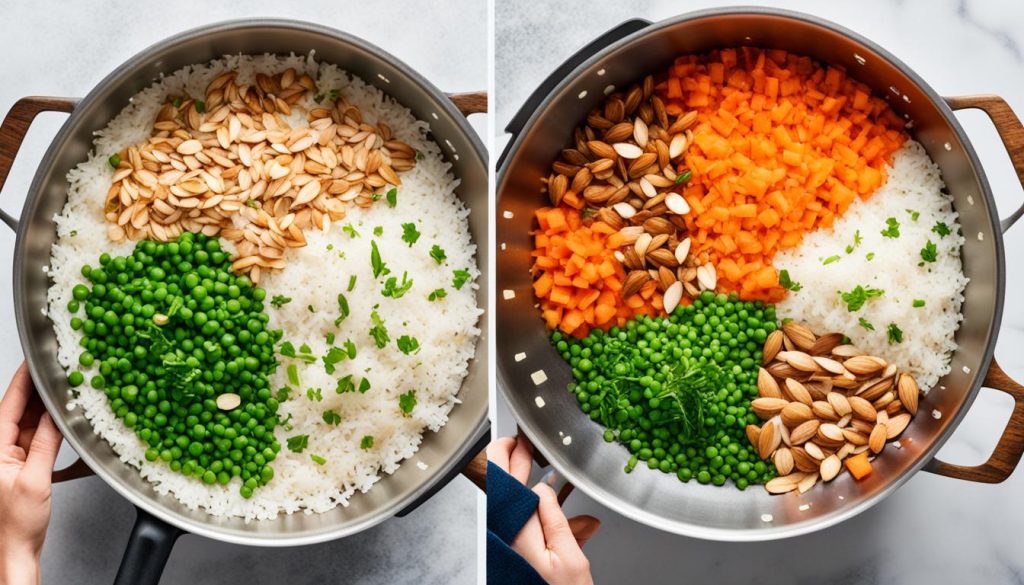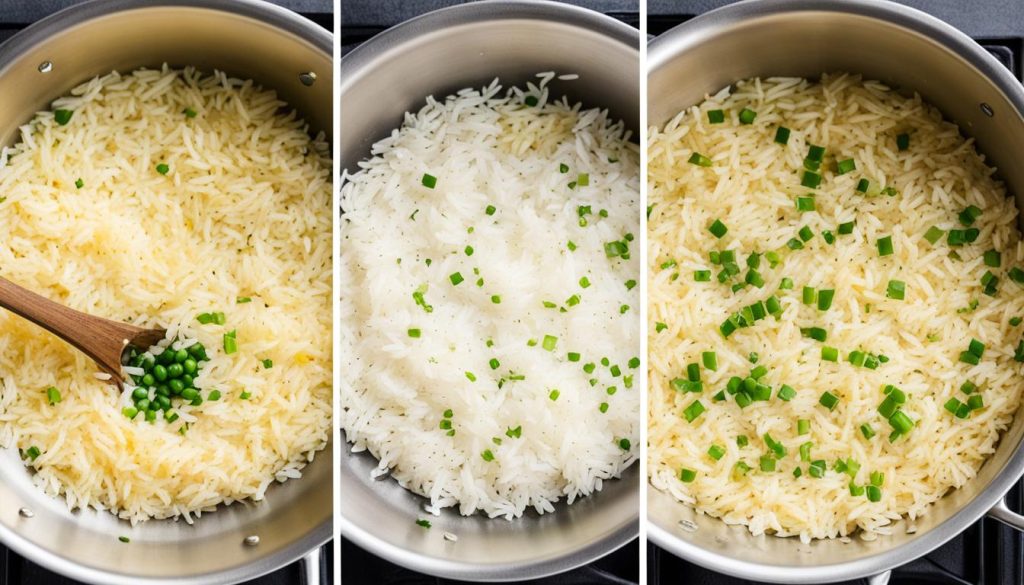If you want to make your meals better, consider a traditional rice pilaf recipe. It’s a dish from the Middle East, known for its flavorful basmati rice, tasty spices, and sautéed onions. It’s all cooked in a seasoned broth, creating a rich taste that’s more than just plain rice. The key to great rice pilaf is in the mixing of its unique cooking and chosen ingredients.
Traditional recipes often use basmati or jasmine rice with herbs and spices in the broth. The rice is first toasted in butter or oil, giving it a nutty taste and fluffy texture. You have many options like vegetarian, Middle Eastern, or adding meat or seafood. This makes rice pilaf a very flexible side dish.
Key Takeaways
- Rice pilaf is a fragrant and flavorful Middle Eastern dish made with long-grain rice, aromatics, and seasoned broth.
- Traditional rice pilaf recipes typically include toasting the rice in butter or oil before simmering in the broth, which adds depth of flavor.
- Rice pilaf can be customized with a variety of vegetables, meats, herbs, and spices to create endless variations.
- Rice pilaf is a versatile side dish that can complement a wide range of main courses and cuisines.
- Mastering the art of making traditional rice pilaf at home is easier than you might think, with the right techniques and ingredients.
Understanding Rice Pilaf
Rice pilaf comes from the Middle East and Central Asia, where people have eaten it for centuries. Its name, “pilaf,” is from the Persian word “پلو” (polo). Throughout the area, different versions of rice pilaf reflect their own history of rice pilaf and origins of rice pilaf.
Origins and History
Rice pilaf’s story starts with ancient Persian and Central Asian food. It was a special dish for big events. As time passed, places in the region added their unique touches. This created the rich diversity of rice pilaf we enjoy today.
Difference from Plain Steamed Rice
Rice pilaf and plain steamed rice are not the same. Plain steamed rice is cooked in water or broth. But, rice pilaf is cooked in a seasoned broth. It might have onions, garlic, and spices added. This method, including toasting the rice, brings out a more complex taste. It makes rice pilaf stand out from simple steamed rice.
What is a Traditional Rice Pilaf Recipe?
A traditional rice pilaf recipe has some key parts:
| Ingredient | Description |
|---|---|
| Long-Grain Rice | It uses basmati or jasmine rice. These types make the pilaf light and fluffy. |
| Broth or Stock | The rice cooks in a tasty broth. This broth can be chicken, vegetable, or beef. |
| Aromatics | Onions, garlic, and maybe celery or carrots are sautéed first. They start the dish’s flavor. |
| Spices and Herbs | It is seasoned with spices like cumin, coriander, and cinnamon. Herbs like parsley or dill add more flavor. |
The recipe begins by toasting the rice in oil or butter. This step makes the rice taste nutty. Then, you simmer the rice in the broth. This helps the rice absorb all the delicious flavors. The end result is a rich, fluffy traditional rice pilaf.

Key Ingredients
In a traditional rice pilaf, key ingredients are crucial for its flavor and texture. These include different rice types, broth or stock, and selected seasonings. Each part plays a big role in making the dish tasty.
Rice Varieties
For a classic rice pilaf, you mainly use long-grain rice like basmati or jasmine. These varieties are known for their light, fluffy feel and gentle smell. They match the savory broth and spices well. Basmati rice brings a nutty taste and keeps its individual grains. On the other hand, jasmine rice is softer. You can also use other varieties like those from Persia or Iran.
Broth or Stock
The liquid for cooking the rice is vital. The top choice is usually a rich, tasty stock like chicken or vegetable. This stock makes the rice flavorful as it cooks. Sometimes, you might mix broth with water or use a type of vegetable or meat-based broth.
Aromatics and Seasonings
For flavor, pilaf often includes onions, garlic, saffron, and various spices. These items are cooked in oil or butter first. This makes the dish smell amazing from the start. You can also add herbs like parsley, dill, or cilantro. They bring a fresh taste to the pilaf.
Basic Cooking Method
To make a tasty and real
rice pilaf
, you need to follow some important steps. Here’s a breakdown of each:
Sautéing the Aromatics
First, warm up oil or butter in a big pot over medium heat. Add onions, garlic, and any extras like celery or spices when the fat is hot. Cook until they smell good and the onions are clear, usually 5-7 minutes. This step lays the flavor foundation for your rice pilaf.
Toasting the Rice
Then, put in the long-grain rice like basmati or jasmine. Keep stirring for 2-3 minutes to make it toast well and smell nutty. Toasting the rice makes it tastier and fluffier in the end.
Simmering with Broth
After toasting, add your broth or stock. Let it come to a boil, then turn the heat down, cover, and simmer for 15-20 minutes. Don’t lift the lid; it needs to steam to cook perfectly.
Do these steps – from sautéing the aromatics, toasting the rice, and simmering with broth. You’ll make a delicious rice pilaf perfect as a side or for many dishes.

Variations and Add-Ins
While a basic rice pilaf recipe is tasty, there are lots of ways to make it your own. You can add different vegetables or include meat or seafood. This allows for a wide range of unique and delicious rice pilaf recipes.
Vegetable Rice Pilaf
Start with sautéed vegetables like carrots, bell peppers, or peas. You can also include leafy greens such as spinach. Adding these not only boosts the taste but also makes your vegetable pilaf look great. Mix and match veggies to create a vegetable rice pilaf that’s all your own.
Meat or Seafood Rice Pilaf
If you want something more filling, consider adding cooked meat or seafood. Options include chicken, beef, or shrimp. Sauté them with the vegetables and the rice will soak up all those delicious flavors. Seafood lovers can enjoy a shrimp, scallop, or fish rice pilaf.
Herb and Spice Blends
Play around with herbs and spices to give your rice pilaf a unique taste. Mix Middle Eastern spices like cumin and cinnamon for a rich flavor. For a Mediterranean touch, add herbs like oregano and thyme. Or, turn to spices like turmeric or saffron for an Indian flair. The choices for seasoning your pilaf are limitless.
Serving Suggestions
Rice pilaf is a flexible dish for any meal. You can serve it as the main course or a side. Knowing how to serve rice pilaf ensures it goes well with your food.
Main Dish or Side
As a main course, rice pilaf shines. It goes great with grilled chicken, lamb, or shrimp. This turns it into a satisfying meal. As a side, it complements many entrees. It goes well with roasted meats, fish, or vegetarian dishes.
Pairing with Proteins
Rice pilaf’s savory flavor suits many proteins. It’s perfect next to grilled chicken, lamb, or salmon. For vegetarians, it works great with tofu or roasted veggies. It’s also good with lentils or chickpeas.
No matter how you serve it, rice pilaf is tasty and versatile. It can make any meal better and please your palate.
Tips and Tricks
To make your rice pilaf awesome, use these simple tips. Start by rinsing the rice. Adjust the amount of liquid you use. This way, you’ll get a dish that’s both light and tasty every time.
Rinsing the Rice
Rinsing the rice is a key step. It removes the extra starch that can make the rice sticky. Place the rice in a strainer and rinse it with cool water until clear. This will give your pilaf a great texture.
Adjusting Liquid Ratios
Liquid is crucial for a perfect rice pilaf. For every cup of rice, you usually need two cups of broth or stock. But, this can change slightly based on the rice type or what texture you like.
Make-Ahead and Reheating
Rice pilaf is great for making in advance. Cook it, let it cool, and then store it in your fridge. You can keep it up to 4 days. To serve, just reheat it gently in a skillet with a bit of broth or water. It’s perfect for getting ahead on busy nights or when you’re having guests over.
Conclusion
Rice pilaf is a Middle Eastern dish that makes plain rice exciting. It uses techniques like sautéing and toasting for flavor. You can make it your own by trying different ingredients and seasonings. This dish is great with many foods and cuisines, both as a side or a main meal. With practice, you can easily cook this at home.
Rice pilaf from the Middle East is a treat that you can adjust to suit your taste. The right steps and ingredients help you make a dish that’s light, scented, and full of flavor. It turns simple meals into something special, fitting with a variety of dishes. Getting good at cooking this dish enriches your cooking skills.
This rice dish is all about making it how you like it. You can go with a basic method or get creative with different stuff you want to add. It’s a tasty choice that goes well with many foods. With a few tips, you can make a dish that smells great, is light, and tastes awesome. Your loved ones will enjoy it whenever you serve it.


